1995 Oldsmobile Cutlass Supreme high beam
[x] Cancel search: high beamPage 7 of 340

Vehicle Symbols
These are some of the symbols you may find on your vehicle.
3.
For example,
these sym%ols
are used on an
original battery:
POSSIBLE A
CAUTION
INJURY
PROTECT EYES BY
SHIELDING
CAUSTIC
BURNS
SPARKS
OR
FLAMES
SPARK
OR
FLAME ,I#$,
COULD
EXPLODE
BATTERY
These symbols are important
for you and
your passengers
whenever your vehicle is
driven:
POWER
WINDOW n-
These symbols
have to do with your lights:
SIGNALS e
TURN
pA;:z
pf
WARNING A
HAZARD
FLASHER
HIGH
LAMPSoR BEAM = =o
FOG LAMPS 3 0 '
These symbols
are on some
of
your controls:
WINDSHIELD
WIPER
'r' -4
WINDSHIELD 6$
WASHER I
WINDSHIELD
DEFROSTER
REAR
WINDOW
DEFOGGER
VENTILATING
b
. FAN
These symbols are used
on
warning and
indicator lights:
CHARGING ,I-1
BAllERY
SYSTEM
BRAKE
(a)
RADIATOR COOLANT
a
ENGINE OIL
PRESSURE Wh
. TEMP OIL
ANTI-LOCK
(@)
BRAKE
Here are some
other symbols
you may see:
FUSE
RADIO
k
VOLUME a
CONDITIONING AIR 43
LIGHTER k
SPEAKER
b
V
Page 83 of 340
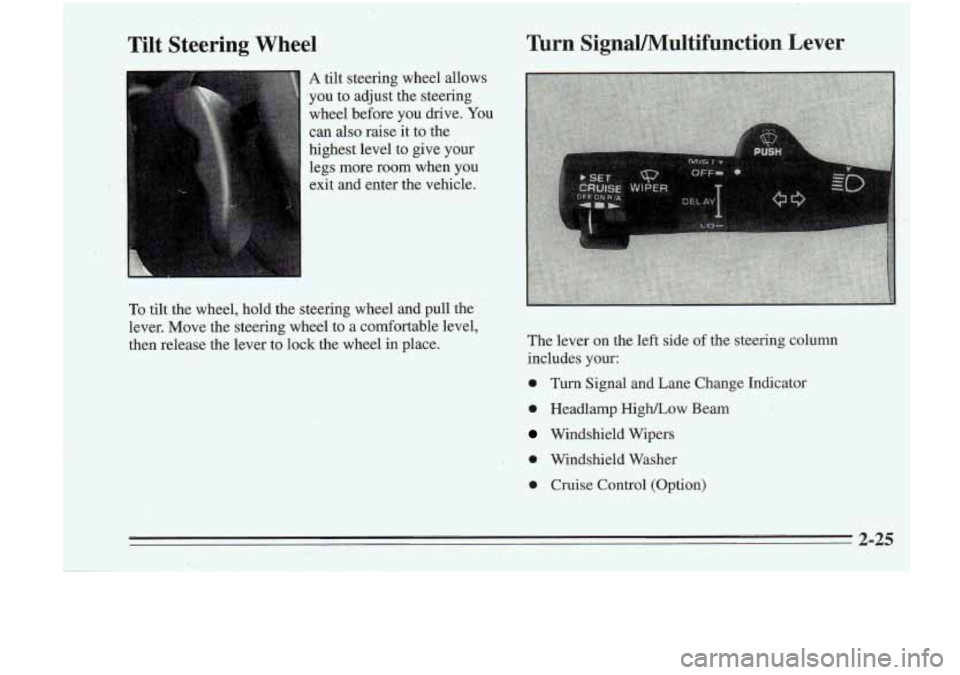
c
Tilt Steering Wheel
A tilt steering wheel allows
you to adjust the steering
wheel before you drive. You
can also raise it to the
highest .level to give your
legs more room when you
e& and enter the vehicle.
To tilt the wheel, hold the steering wheel and pull, the
lever. Move the steering wheel to
a comfortable level,
then release the lever to lock the wheel in place.
Turn SignaVMultifunction Lever
The lever on the left side of the steering column
includes your:
"
0 Turn Signal and Lane Change Indicator
0 Headlamp HighLLow Beam
Windshield Wipers
0 Windshield Washer
0 Cruise Control (Option)
2-25
Page 84 of 340
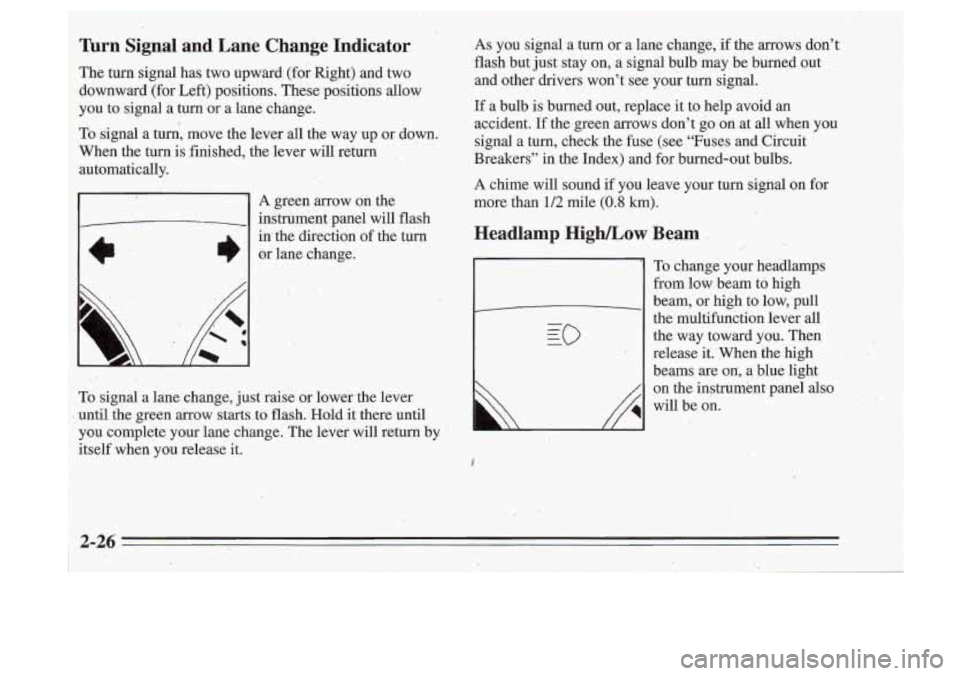
.,’
I
nrn Signal and Lane Change Indicator
The turn signal has two upward (for,Right) and two
downward (for Left) positions. These positions allow
you to signal a turn or a lane, ch&ge.
To signal a turn, move the lever all the way up or down.
When the turn
is finished, the lever will return
automatically.
’ A green arrow on the
- instrument panel will flash
in’the direction
of the turn
e br lane change.
,* I I. ..
To signal a lane change, just raise or lower the lever
until the green
arrow starts. to flash. Hold it there until
you complete your lane change. The lever will return
by
itself when you release it.
..
As you signal a turn or a lane change, if the arrows don’t
flash but Just stay on, a signal bulbmay be burned out
and other drivers won’t see your turn signal.
If a bulb is burned out, replace it to help avoid an
accident. If the green arrows don’t go on at all when you
signal
a turn, check the fuse (see “Fuses and Circuit
Breakers” in the Index) and for burned-out bulbs.
A chime will sound if you leave your turn signal on for
more than,
1/2 mile (0.8 km):
Headlamp HighLow Beam
I
I
To change your headlamps
from low beam to high
beam, or high
to low, pull
the multifunction lever all
the way toward you. Then
release it.’When the high
beams are
oni, a blue light
on the instrument panel also
will be on.
2-26
..
’. . .-. -..
Page 113 of 340

Head-Up ,Display (Option)
If you have the Head-Up Display (HUD), you can see
the speedometer reading, in English or metric units,
displayed “through” the windshield.
The HUD
also shows these lights when they are lit on
the instrument panel:
0 Turn Signal Indicators
0 High-Beam Indicator Symbol
Low Fuel Symbol
Oil Warning Symbol
0 Coolant Temperature.Symbo1
Charging System Symbol
I
When you sit straight in your seat, the HUD image will
appear slightly to the right.
When the ignition key is turned to RUN, all possible
HUD images will come on. Then the Head-Up Display
will operate normally.
NOTICE: 1.
Although the HXJD image appears to be near the
front of the vehicle, do not use it as a parking aid. The
.HUD was not designed for that purpose. If
you try to use it that way,-such as in,a parking
lot, you may misjudge distance and run into
something.
J
2-55
. ..
Page 152 of 340
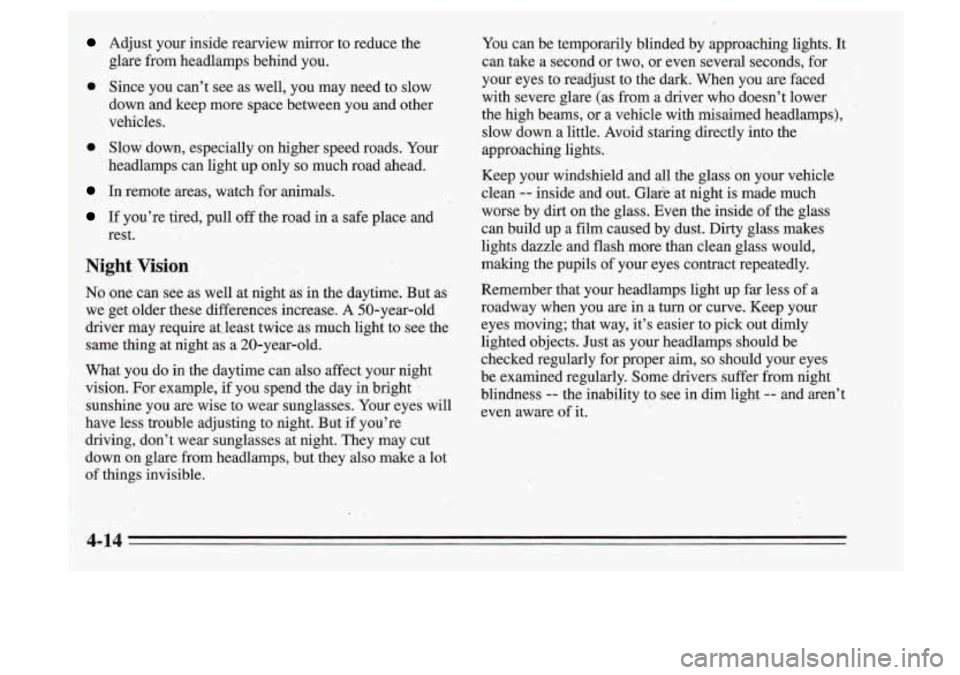
Adjust your inside rearview mirror to reduce the
. glare from headlamps behind you.
,e Since you can’t see as well, you may need to slow
down and keep more space between you .and other
. .. : vehicles.
Slow down, especially
on higher speed roads. Your
beadlpps can light up only
so much road ahead.
In remote areas, watch for animals.
If you’re tired, pull off the road in a safe place and
Night, Vision
No :one can see as well at night as in the daytime. But as
we get older these differences increase. A 50-year-old
driver may require at. least twice as much light to see the
same thing at night as a 20-year-old.
What you do
in the daytime can also affect your night
vision.
For example, if you spend the day in bright .
sunshine you are wise to wear sunglasses. Your eyes will
have less trouble adjusting to night.
Bat if you’re
driving, don’t wear sunglasses at night. They may cut
down on glare from headlamps, but they also make a lot
of things invisible. rest.
You
can be temporarily blinded by approaching lights. It
can take a second or two, or even several seconds, for
your eyes to readjust to the dark. When you are faced
with severe glare (as from a driver who doesn’t lower
the high beams, or a vehicle with misaimed headlamps), slow down a little. Avoid staring directly into the
approaching lights.
Keep your windshield and all
the glass on your vehicle
clean
-- inside and out. Glee at night is made much
worse by dirt on the glass. Even the inside of the glass
can build up a film caused by dust. Dirty glass makes
lights dazzle and flash more than clean glass would,
making the pupils
of your eyes contract repeatedly.
Remember that your headlamps light up far less of
a
roadway when you are in a turn or curve. Keep your
eyes moving; that way, ips easier to pick out dimly
lighted objects. Just as your headlamps should be checked regularly for proper aim,
SO should your eyes
be examined regularly. Some drivers suffer from night
blindness
3- the inability to see in dim light -- and aren’t
even aware of it.
4-14 .. .. .
Page 154 of 340
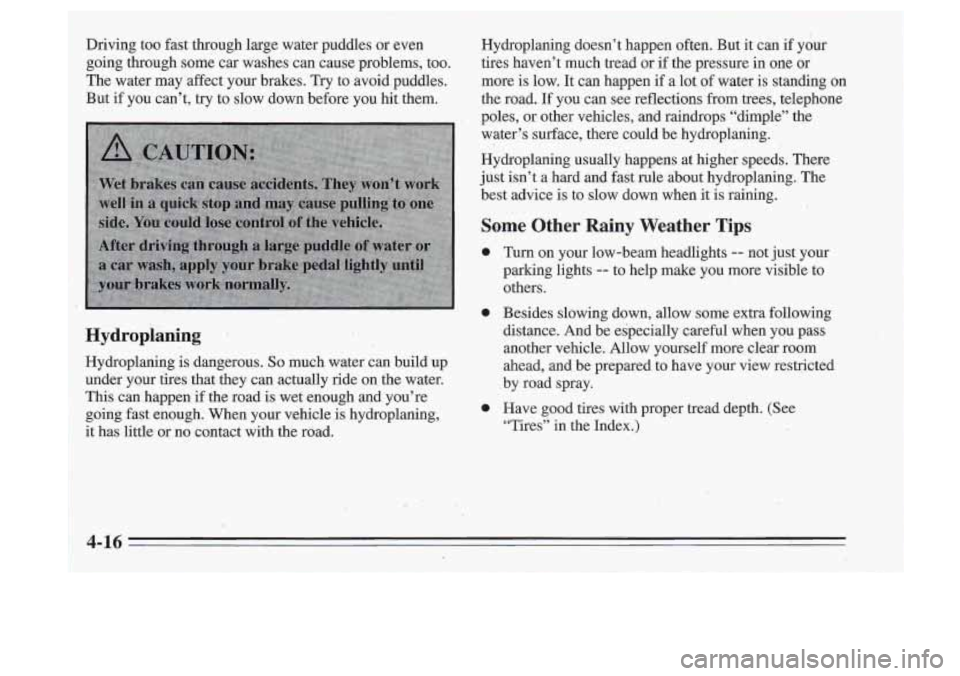
!
Driving too fast through large water puddles or even going through some car washes can cause problems, too.
The water may affect your brakes. Try to avoid puddles.
But if you can’t, try to slow down before you hit them.
Hydroplaning
Hydroplaning is dangerous. So much water can build up
under your tires that they can actually ride on the water.
This can happen if the road is wet enough and you’re
going fast enough. When your vehicle is hydroplaning,
it has little or no contact with the road. Hydroplaning doesn’t .happen often. But
it can if your
tires haven’t much tread or
if the pressure in one or
more
is low. It can happen if a lot, of water is standing on
the road. If you can see reflections froin trees, telephone
poles,
or other vehicles, and raindrops “dimple” the
water’s surface, there could be hydroplaning.
Hydroplaning usually happens at higher speeds. There
just isn’t a hard and fast
rule about hydroplaning. The
best advice
is to slow down when it is iaining.
Some Other Rainy weather Tips
1
0
0
0
,Turn on your low-beam headlights -- not just your
parking lights
-- to help make you ,more visible to
others.
Besides slowing down, allow some extra following distance. And be especially carefbl when you pass
another vehicle. Allow yourself more clear room
ahead, and, be prepared to have your view restricted
by road spray.
Have good tires with proper tread depth. (See “Tires” in the Index.)
Page 331 of 340
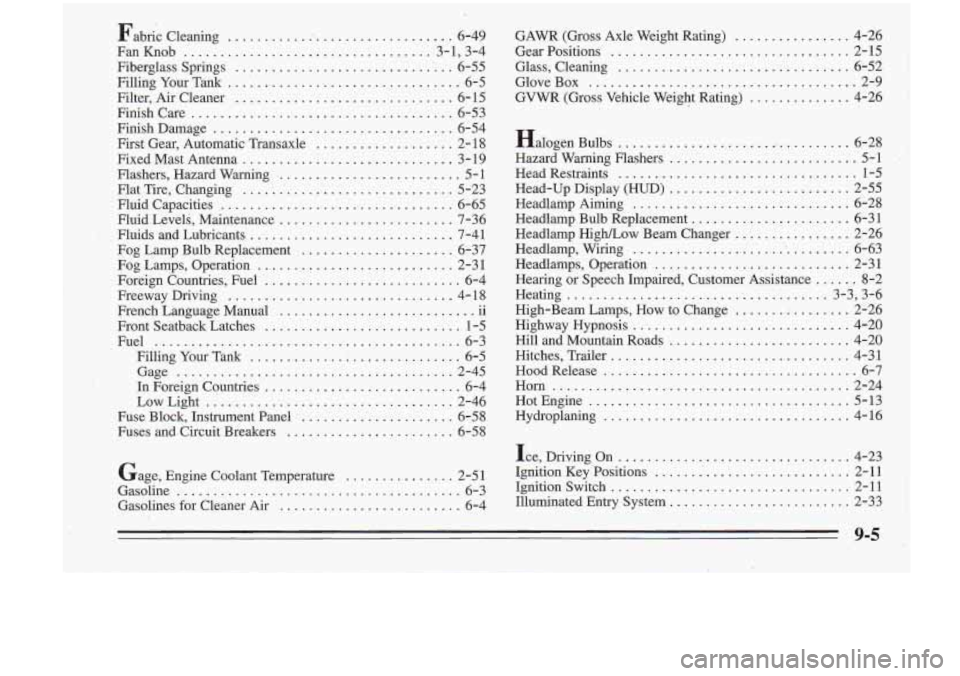
Fib& Cleaning ............................... 6-49
FanKnob
.................................. 3.1. 3.4
Fiberglass Springs
............................... 6-55
Filling Your Tank
... ............................ 6-5
Filter. Air Cleaner
.............................. 6- 15
Finishcare
.................................... 6-53
Finish Damage
................................. 6-54
First Gear. Automatic Transaxle
................... 2-18
FixedMastAntenna
............................. 3-19
Flashers. Hazard Warning
......................... 5-1
Flat Tire. Changing
............................. 5-23
Fluid Capacities
................................ 6-65
Fluid Levels. Maintenance
........................ 7-36
Fluids
and Lubricants ............................ 7-41
Fog Lamp Bulb Replacement
....................... 6-37
Fog -Lamps. Operation
........................... 2-3 1
Foreign Countries. Fuel ....... ................... 6-4
Freeway Driving
............................... 4- 18
French Language Manual
11
Front Seatback Latches ........................... 1-5
Fuel
.......................................... 6-3
Filling Your Tank
............. : ............... 6-5
Gage
...................................... 2-45
In Foreign Countries ........................... 6-4
Fuse Block, Instrument Panel
..................... 6-58
Fuses and-Circuit Breakers
................. ....... 6-58
.. ...........................
LowLight ................................... 2-46 GAWR
(Gross Axle Weight Rating)
................. 4-26
Gear Positions
................................. 2-15
Glass. Cleaning
................................ 6-52
Glove Box
...................................... 2-9
GVWR
(Gross Vehicle Weight Rating) .............. 4-26
Halogen Bulbs
................................. 6-28
Hazard Warning Flashers
.......................... 5-1 .
Head Restraints ................................. 1-3
Head-Up Display
(HUD) ......................... 2-55
Headlamp Aiming
.............................. 6-28
Headlamp Bulb Replacement
...................... 6-31
Headlamp HighLow Beam Changer
................ 2-26
Headlamp. Wiring
............................... 6-63
Headlamps. Operation
........................... 2-31
Hearing or Speech Impaired. Customer Assistance
...... 8-2
Heating
....................................... 3-3., 3-6
High-Beam Lamps. How to Change
....... .. ........ 2-26
Highway Hypnosis
............................... 4-20
Hill and Mountain Roads
......................... 4-20
Hitches, Trailer
................................. 4-31
Hood Release
................................... 6-7
Horn ......................................... 2-24
HotEngine
.................................... 5-13
Hydroplaning
.................................. 4-16
Ice. Driving On
................................ 4-23
Gasoline
....................................... 6-3 Ignition Switch 2-11
Gasolines for Cleaner
Air ......................... 6-4 Illuminated Entry System 2-33
Gage.
Engine Coolant Temperature
............... 2-51 Ignition Key Positions ........................... 2-11
.................................
.........................
9-5
'I